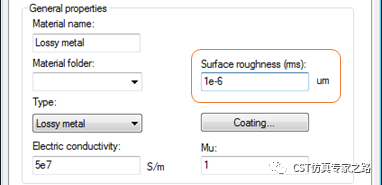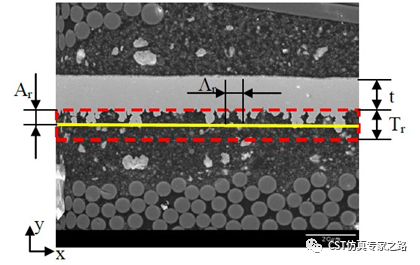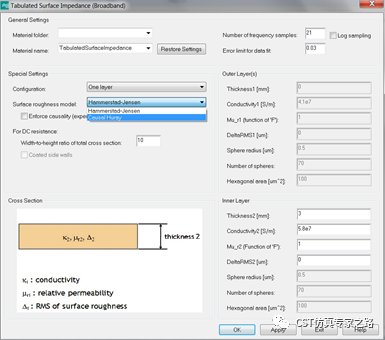CST 软件如何设置金属材料表面粗糙度
粗糙的介绍:本文介绍如何添加金属表面粗糙度。
1) 材料中直接定义
对于 lossy metal,最简单的就是材料定义的时候,添加 surface roughness:

这个 RMS 值是指 Gradient Model 中的随机正态分布方差,参考文献为:
G. Gold and K. Helmreich, „A Physical Model for Skin Effect in RoughSurfaces“, Proc. 42 European Microwave Conference, 2012
G. Gold and K. Helmreich,Surface Impedance Concept for Modeling Conductor Roughness, IEEE MTT-SInternational Microwave Symposium, 2015
好处就是方便,一个值 RMS 就可以表示粗糙度,按 DINEN ISO 4287 测 Rq 就是了。经常有用户问到,其他的 DIN EN ISO 4287 测量值,比如 Ra,Rz 等,可用用于电磁仿真吗?由于不能直接转换成 RMS , 无法直接使用。如有计算电磁相关文献使用 Ra,Rz,欢迎留言讨论。


Koledintseva,Razmadze, Gafarov, De, Drewniak, Hinaga, PCB Conductor Surface Roughness asa Layer with Effective Material Parameters, Electromagnetic Compatibility(EMC), 2012 IEEE International Symposium 2012
2) 宏创建材料
Macros ->Materials-> Create Tabulated Surface Impedance Material
这个宏会生成 lossy metal 材料,适合趋肤深度远大于金属厚度,或金属厚度远大于趋肤深度。换句话说,他在生成 lossy metal 的时候,低频模型更加准确,适合高频低频共同求解。具体操作先不谈,这里只介绍表面粗糙度。

这里有两个表面粗糙度模型,Hammerstad-Jensen 和 Causal Huray。HJ 历史较久,是 Empirical Model 经验模型,需要经验矫正因子(correction factors),当然宏内部已经使用了校正因子,不需要用户定义,只需要用户输入 DeltaRMS 值。
HJ 模型一些有效性文献:.
Hammerstad and O. Jensen, „Accurate Models for Microstrip Computer-Aided Design“, IEEE MTT-S International, 1980
Measurement of High-Frequency Conductivity Affected by Conductor Surface Roughness Using Dielectric Rod Resonator Method”, ToshikiIwai, Daisuke Mizutani and Motoaki Tani, IEEE EMC Dresden, 2015
M.P. Kirley, J. Booske, „Terahertz conductivity of copper surfaces“, IEEE Transactions on Terahertz Science and Technology,Vol. 5, No. 6 November 2015
Huray 的雪球模型更详细表示粗糙表面,需要用户定义雪球半径,数量,及六边形面积。Huray 模型一些有效性文献:
P.G. Huray et al., Fundamentals of a 3-D snowball model for surface roughness power losses, IEEE Workshop on Signal Propagation on Interconnect,2007
M.V. Lukic and D. S. Filipovic, Modeling of 3-D Surface Roughness Effects With Application to Coaxial Lines, IEEE Trans. Microwave Theory andTechniques, 2007
P.G. Huray et al., “Impact of Copper Surface Texture on Loss: A Model that Works”, in DesignCon 2010 Proceedings, Santa Clara,CA, 2010
更详细的解释可见下文:
E. Bogatin, D. DeGroot, P. G. Huray, Y. Shlepnev, “Which one is better? Comparing Options to Describe Frequency Dependent Losses”,DesignCon2013 Proceedings, Santa Clara, CA, 2013.
HJ 和 Huray 模型在时域有个因果性问题,所以这个宏会提升因果性,保证其在时域仿真中的质量,所以这里名字就改成了 Causay Huray。

【推荐内容】










评论